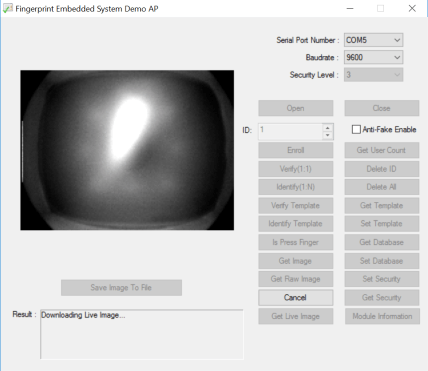Review: Optical fingerprint recognition with the GT-521F52
Communicating with the GT-521F52
The communication protocol is binary and briefly described in the Programming Guide. Unfortunately it does not say if (D)WORDS are little or big endian (the GT-511 documentation mentions little endian). Luckily the manufacturer provides a precompiled Visual C++ 2005 project (including source code) that allows you to try out the module with a Windows computer. On my Windows 10 computer this little tool worked fine. With the tool you can not only get some information about the module’s firmware and capabilities, you can capture and visualize prints, and interact with the template database. You can even use the module as a (slow) live "camera" of rather mediocre quality, a function intended for calibration and debugging.
Enroll to get started
It all starts, of course, by capturing fingerprints. This process is called ‘enrollment’ and consists of taking three scans of the same finger that are merged into one template (if you try three different fingers enrollment will fail). Once you have enrolled one or more users you can try to verify—compare a scan to a given template—or identify—try to find a match in the database—them. You can also export them or import other templates if you happen to have any.Security levels can be specified, but the documentation does not explain what this means nor how to use it. The same thing is true for the Anti-Fake option.
Conclusion
The GT-521F52 fingerprint scanner module with scratch-proof sensor works well with dry, moist and even rough fingerprints. Although the documentation is insufficient, embedding the module in a project is not too complicated; a full-featured demonstration program including source code is available for reference. Thanks to its high-level fingerprint processing capabilities and serial port communication the GT-521F52 is a very easy way to add a high-security access control or identification feature to a user project or product.Keep your fingers to yourself!
Finally: this article does not contain images of fingerprints. The reason is that it is highly insecure to publish your fingerprints as somebody might steal them.Read full article
Hide full article


Discussion (0 comments)